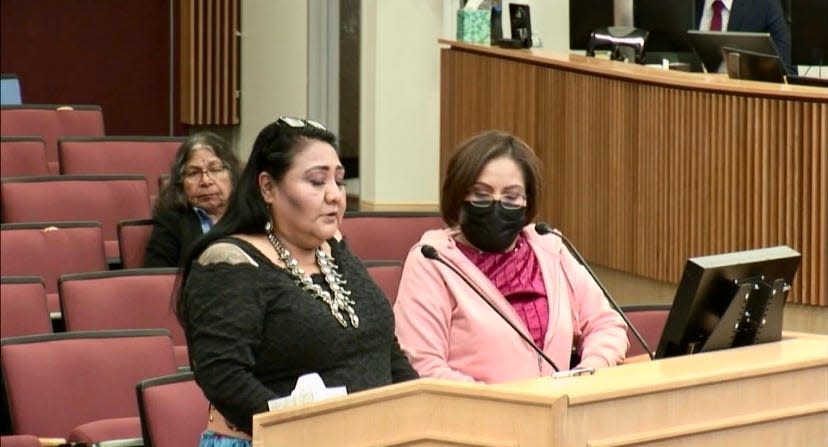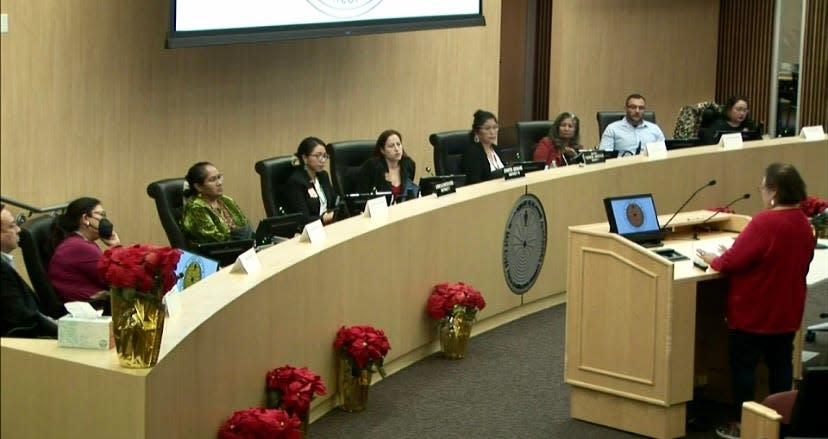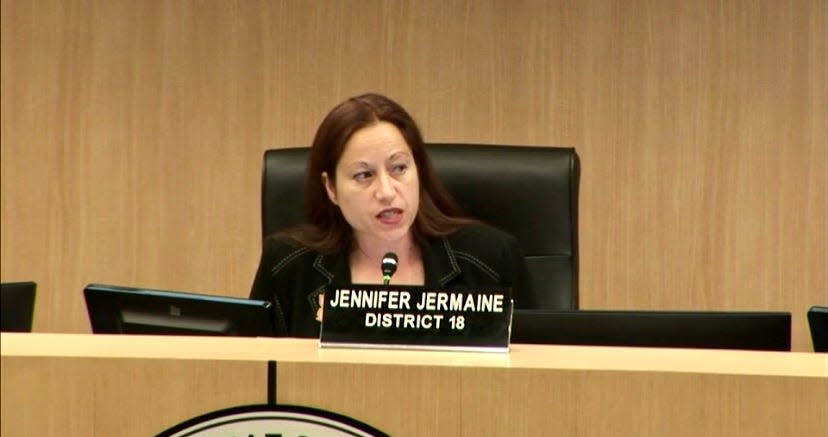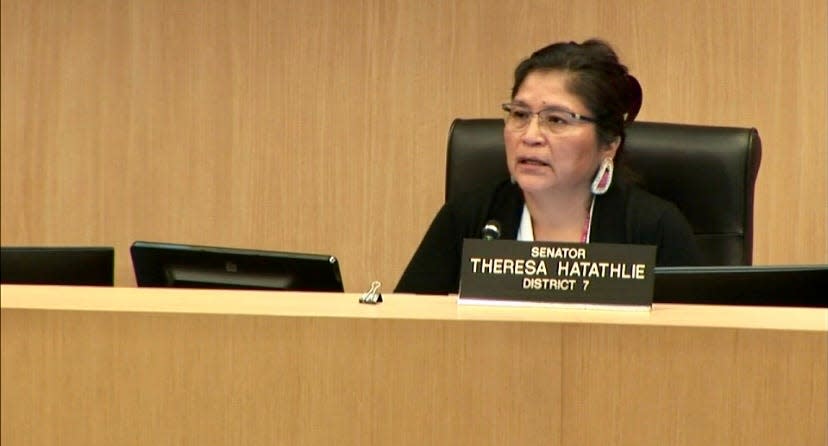Unregulated rehab centers are victimizing Indigenous patients, advocates tell Arizona lawmakers

- Oops!Something went wrong.Please try again later.
Reva Stewart got a call from a relative on the Navajo Nation telling her that Stewart's cousin was missing and asking her to keep an eye out for her in the Phoenix area, which is where the relative believed the cousin to be.
But the circumstances behind the cousin’s disappearance were peculiar, Stewart said later. The cousin called her family and told them she was in Phoenix, but didn't say how she got there or why. The answers to those questions surprised Stewart when she drove out to get her cousin.
“They told me they knew my brother,” Stewart remembered her cousin telling her. “We were going on a one-day trip and they would bring me home the next day. It only started with four people in that Suburban but more got in later. One guy said he worked at San Juan hospital and he knew my brother and told me he comes down to the Valley for the weekends,” the cousin told Stewart.
The encounter, leading to what some say is human trafficking, has become an increasing concern and has been reported not only on the Navajo Nation but in other tribal communities across the state. It was the focus of a hearing last month of the legislative Ad Hoc Committee for Missing and Murdered Indigenous Peoples, where Stewart and others told their stories.
They talked about how scammers target the most vulnerable individuals in tribal communities, people who are unsheltered, battling substance and alcohol abuse, or suffering from various mental illnesses and who are often found walking throughout towns close to the Navajo Nation, like Farmington and Gallup. The people are picked up, promised help at sober living centers or rehab centers, and taken to complete paperwork.
But authorities say these scammers work for treatment homes that try to take advantage of the Arizona Health Care Cost Containment System, using so-called pop-up sober living centers scattered throughout the city.
The system's American Indian Health Program provides medically necessary services for enrolled members, including coverage for preventive and behavioral health care services.
"I know AHCCCS is aware of it. But how far will it go before they do something," said Stewart in a phone interview with The Arizona Republic.
The Republic reached out to AHCCCS, but no one has returned the call.
Some people aren't allowed to leave the centers

Though some people have gone willingly, some are also coerced or forced, Stewart said. She and Coleen Chatter, both enrolled members of the Navajo Nation, have been working to bring this to the attention of authorities and tribal leaders for months. Some advocates believe the scams are contributing to the growing number of missing Indigenous people.
Chatter lost her sister in 2011. The sister, she said during the public hearing, was recruited by an individual in her community to go to a group home. Such sober living facilities aren't new, she said, and since the start of the pandemic, AHCCCS seemingly has not been regulating the facilities. Chatter said the agency also hasn't been regulating nonmedical transportation companies, which was previously reported to be another form of predatory service found on the Navajo Nation.
"Each of us has a unique story to tell," said Chatter, who has paid for victims to get home. "My sister, because of the extent of alcohol and drugs used in these group homes, there was domestic violence that happened, and she was dropped off in front of PIMC (Phoenix Indian Medical Center). And ever since then I've been advocating. Something's gotta be done."
Stewart’s cousin was able to leave the center where she was taken, but Stewart said there are others who are still holed up in such facilities, and she has heard countless stories from people who escaped or from victims' families who described the buildings as unsafe and cramped with other Indigenous victims.
“These unsheltered Native people have told us they have escaped from these homes,” said Stewart. “Some are literally locked inside these homes from the outside. Some of these Native people had to escape over the walls. Some homes we looked at have cameras all over the place.”
At a meeting of the legislative Ad Hoc Committee for Missing and Murdered Indigenous Peoples last month on the Salt River-Pima Maricopa Indian Community, members of the committee, such as State Rep. Jennifer Jermaine, the chairperson, discussed a rise in missing people being found at drug and alcohol treatment centers in Phoenix.
“It is illegal through federal and Arizona law to pay individuals to procure patients for treatment at these centers,” said Jermaine, D-Chandler. “And several cases have been referred to the U.S. Attorney's Office for prosecution. We are exploring going after the licensing of these organizations under the Arizona Department of Health Services.”

People are left without clothes, phones or money
State Sen. Theresa Hatathlie is well aware of this concern. As a member of the committee, Hatathlie said she was notified by a couple whose son was missing. The son had last been seen at a grocery store where he usually hung out.
“Many of our relatives are out there with various forms of addiction,” said Hatathlie, a Democrat. “This young man’s addiction was alcohol. Many knew him and knew where he usually hung out. They did searches in the community. This continued throughout the summer.”
In August, Hatathlie said the mother got a call from her son and he told his mom he was actually picked up at this grocery store by employees of a rehab center. He said they brought him to Phoenix and he was not able to contact anyone. When he was finally allowed to contact his parents, he said he wanted to stay in the center.
Bringing awareness:Families and advocates seek justice for missing and murdered Indigenous people
“All in all, these are the types of stories I’d prefer to hear,” said Hatathlie. “However, I do know of two scenarios where the parents had to say their final goodbyes. Some of these clients were picked up in that same fashion, were found by metropolitan police out here with inadequate shoes, and then clothes they don't normally wear, without identification, cell phones or money.”
Gila River Indian Community Lt. Gov. Monica Antone spoke at the meeting and said members of her tribe have been reaching out to her with their concerns about these homes. As a leader, she has been told stories, including one that sticks with her about a woman who may have been sexually assaulted.
“I personally have brought a couple of our community members to our tribal council and worked with our Behavior Health Services, and DHS, and IHS, and we got them on board,” said Antone. “There have been numerous stories. It's starting to be a heinous issue. AHCCCS needs to crunch down on what they’re authorizing.”
Hatathlie said the sober living providers can make a lot of money by going through a process to become certified as an Indian Health Provider under AHCCCS.
“Some of these homes and centers are bringing these individuals and housing them in hotels, in really low-paying hotels, and then shepherded to private medical facilities," said Hatathlie. "They get their bill of health and everything and then shipped back to the central location where they become certified with AHCCCS and they sign up for DES food stamps. Not only is it human trafficking, it's a fraud.”

Authorities link scams to missing people
The Navajo Nation Police recently posted on social media that approximately 77 individuals in the Navajo Nation were missing, with some missing since the 1970s, including 28 females and 49 males. The posters would be distributed and displayed in all Navajo Police Department districts and periodically updated.
In September, the FBI released the second update of its list of Native Americans verified as missing in New Mexico and the Navajo Nation. There was a total of 183 missing Indigenous persons on the latest list: 21 individuals have been added and 24 removed since last month’s list of 186 names was released.
When the list was first released in July, there were 177 names on it. The updated list, current as of Sept. 13, has 115 males and 68 females. Men are reported to be the people who make up most of those who are being targeted and taken to these homes in Phoenix. It's also reported that victims are also taken from New Mexico to Phoenix, it's not just an Arizona issue.
Navajo police posted that they are aware of people, typically in vans or SUVs, recruiting Navajo residents to live in behavioral health residential facilities in Phoenix. Police said the facilities are commonly known as sober homes or group homes. The recruiters do not generally work for just one company and have been spotted at places where gatherings are common, such as flea markets, and often approach people they see walking.
“We encourage residents not to get into vehicles with individuals they do not know, even for a short ride,” stated the social media post.
Attempts for comment from Navajo Police Chief Daryl Noon have been unsuccessful. But Navajo Nation Criminal Investigations Director Michael Henderson wrote in an email to the Republic that the FBI Phoenix office has completed some interviews at locations in Phoenix.
“It shows a common denominator of being enticed with alcoholic beverages at the time people were picked up on the Navajo Nation,” wrote Henderson. “Although the motive behind the incidents are still unclear, there seems to be a scheme of sorts. The FBI and the Navajo Police are encouraging the public to be aware of being enticed to catch a ride and immediately report such activities to the authorities should they experience it.”
Hatathlie met with the Navajo Health, Education and Human Services Committee to talk on the issue further. During this meeting, the Navajo Division of Behavioral and Mental Health Services reported they have raised the issue with AHCCCS. They reported that after the pandemic, Arizona has been allowing more of these centers to open and because of this, the Navajo behavioral health services division has a list of preferred, legitimate centers.
“This has been an ongoing issue for a couple of years,” said Karen Johnson, the clinical director of Navajo Division of Behavioral and Mental Health Services. “I talked to someone at Phoenix Indian Medical Center, they were hearing of clients being picked up and they weren’t cognitive enough to understand what was happening. They would be drinking and picked up, they’d be so inebriated and brought to the ER and almost died. This has been a problem in the Gallup area, and probably the Window Rock area. It happens quite often.”
Stewart’s cousin who was coerced into going to Phoenix told Stewart that because she refused to give her information to the people operating the sober living facility, she was told to leave and given a one-day bus pass. When her pass expired, she began walking all over Phoenix. While on the bus, she was trying to figure out how she would hitchhike back home, but in the end, Stewart found her and her family took her home.
But even if her cousin hadn’t consumed alcohol in over three days at that point, Stewart said her cousin was under the influence of something. Her cousin was unable to tell her where the home she was taken to was but said there were other individuals still there who were also picked up and taken to these sites. After this incident, Stewart and Chatter lent their support to individuals who have experienced these sober home living facilities.
“I think I got over 1,000 pages of people reaching out to me,” said Stewart. “With the help of (Chatter) we started collaborating. We started hearing stories of these people going to flea markets and stores, anywhere just to pick them up. It's unbelievable the amount of stories coming out. Now we have families being recruited into these homes. We've got families who have lost their loved ones because they were found outside of the home. We've had others advocate and they feel their voices haven't been heard. It's more than an epidemic. It's bad."
Arlyssa Becenti covers Indigenous affairs for The Arizona Republic and azcentral. Send ideas and tips to arlyssa.becenti@arizonarepublic.com.
Support local journalism. Subscribe to azcentral.com today.
This article originally appeared on Arizona Republic: Rehab center scams are targeting Indigenous people, advocates say

